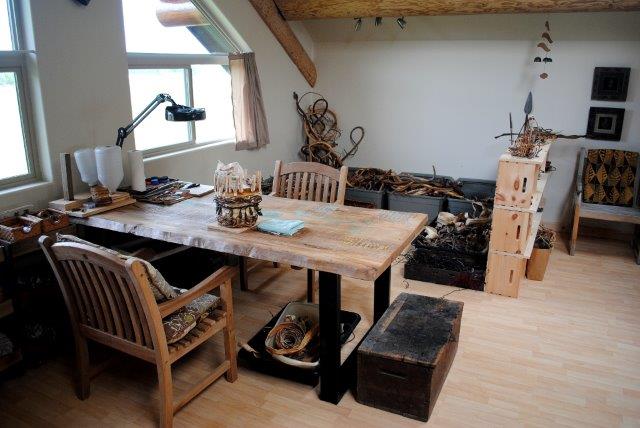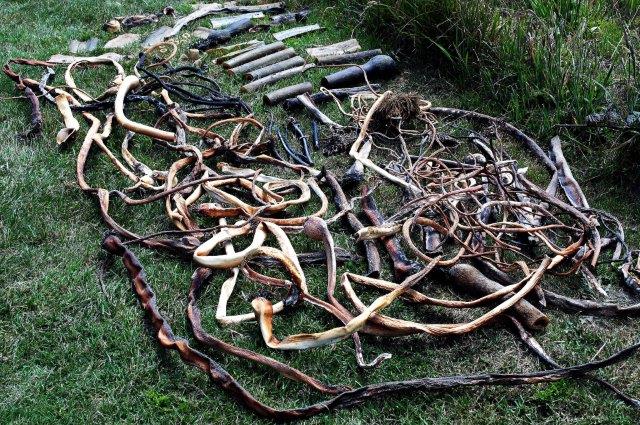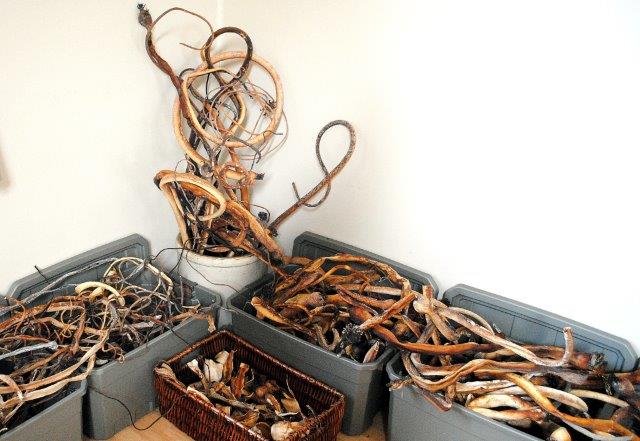
|
HOME |
ABOUT |
STUDIO |
BASKETS |
GALLERY |
FARM |
FACEBOOK |
VIDEOS |
 Our Studio Work Table  Drying Kelp for our Sea Baskets  Dry Kelp for Basket Making
About Our Baskets: The basic building block of all our basket products is Kelp. Bull Kelp to be specific. The kelp that everybody thinks of floating
in the chilly waters off the North West Coast. We have license to harvest living seaweed but we just don't do it. Instead we harvest torn or damaged
seaweed that has drifted up on the beach and in many instances has already begun the natural decomposition process- a process that actually increases
the textural component of the final product. | Once gathered, we put the kelp through a series of washing, dehydrating and re-hydrating that renders it into something that very much resembles leather or tree bark. This gives our baskets the look of Native American crafting, and in fact kelp basketry was a process employed by early area residents of the NW. The process described above is an on-going process through out the construction of the baskets. In order to work with, shape, and design, we need our kelp to be wet. We can only stitch it to hold its shape in that state. But we need it to be fully dried to take and hold the shape we are intending. Too wet? It tears easily. Too dry? It snaps. One thing is for sure: drying kelp has a mind of its own- it twists and contorts and adds immensely to what we do to to make an interesting finished product. Think of it as a product with perfect imperfections. To hold the working kelp in place for final drying, we stitch our baskets- much like a leather moccasin would be stitched. This is in addition to the more usual basketry technique of weaving the kelp into the fabric of the basket. We use either other seaweeds or artificial sinew for stitching. Expect that some stitching will appear to be a bit loose, because while the kelp continues to dry and shrink, the stitching does not. It's function is really to hold the kelp in place until it can fully dry, at which time it is pretty rugged. Once the shape of the basket is finalized, we use “adornments” from the beach – shells, feathers, driftwood and other dried seaweeds- to decorate them. Some of the adornments are again stitched in place, but more often than not they are glued with specialty glues that we have been experimenting with for the last several years. They work very well. While our final baskets are functional for display, collecting, holding dried arrangements, and similar, they are NOT suitable for use with liquids. The fact is that the kelp can and will absorb moisture from the air if it is exposed to excessive moisture. Keep baskets indoors and in rooms with lower humidity when possible. Avoiding all day direct sun will also help to eliminate any possible fading from any materials like raffia that may have been incorporated into the basket. And if you'd like to dust them occasionally, we recommend something like a soft paint brush. You can expect many many years of enjoyment from this unusual product from the sea. All of our baskets are One of a Kind creations, and are sold on a First Come First Served basis! Contact Us: Greg and Marilyn Gundy Sea Basket Farm 312 Cameron Rd., Sequim, WA 98382 Best way to contact us is by email. That way we have a record of our conversations and don't risk an errant phone call... gregumar@yahoo.com But if you need to call: 239-218-5203 Leave a voice mail if we can't pick up. There are many times when we on the tractor or mowing or out in the boat and simply can't get to the phone. We always do our level best to return calls promptly. |